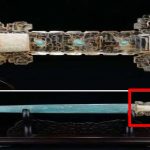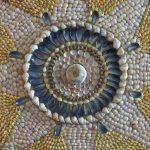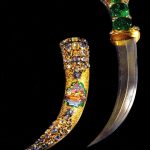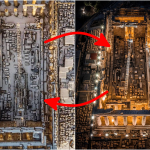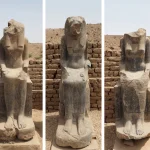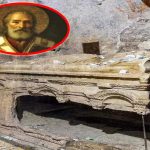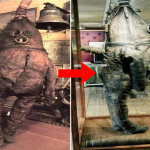A 13th-century BC painting from Pashedu’s tomb in Deir el-Medina, Luxor depicts The Eye of Horus offering Incense to Osiris.

**The Eye of Horus Presents Incense to Osiris: A Painting from Pashedu’s Tomb in Deir el-Medina, Luxor, 13th Century BC**
Nestled amidst the ancient sands of Luxor, Egypt, lies the tomb of Pashedu, a site rich in archaeological treasures and profound insights into the religious beliefs of the ancient Egyptians. Among the many captivating scenes adorning its walls, one stands out: the depiction of the Eye of Horus presenting incense to the enthroned god Osiris. This remarkable painting, dating back to the 13th century BC, offers a glimpse into the elaborate rituals and religious symbolism that permeated the lives of the ancient Egyptians.
The Eye of Horus, known as “Wedjat” in ancient Egyptian mythology, held immense significance as a symbol of protection, healing, and divine power. Often depicted as the left eye of the falcon god Horus, it was believed to possess magical properties capable of warding off evil and restoring balance. In the painting from Pashedu’s tomb, the Eye of Horus takes on a personified form, emphasizing its role as a revered deity in Egyptian religious beliefs. With reverence and solemnity, it offers fragrant incense to Osiris, the god of the afterlife and the underworld.
Osiris, seated majestically on a throne, embodies the ideals of kingship, fertility, and resurrection. As the ruler of the realm of the dead, Osiris held a central place in ancient Egyptian funerary rites and beliefs. His presence in the painting underscores the importance of the afterlife in Egyptian religion and the belief in the soul’s journey to the realm of the gods upon death. The offering of incense by the Eye of Horus symbolizes reverence and devotion to Osiris, seeking his favor and protection in the journey beyond the mortal realm.

The act of offering incense was a common religious practice in ancient Egypt, with deep symbolic significance. Incense, often made from aromatic resins such as myrrh and frankincense, was believed to purify the sacred space, elevate prayers to the gods, and facilitate communication between the mortal and divine realms. By presenting incense to Osiris, the Eye of Horus participates in this sacred ritual, invoking divine blessings and ensuring a favorable outcome in the afterlife for the deceased.
The scene depicted in Pashedu’s tomb reflects the complex cosmology and religious beliefs that shaped ancient Egyptian culture. The interaction between the Eye of Horus and Osiris symbolizes the interconnectedness of the gods and their roles in guiding and protecting humanity. It also highlights the importance of ritual offerings and ceremonies in maintaining cosmic order and harmony.
Pashedu, the owner of the tomb, was likely a skilled artisan or craftsman who worked in the royal necropolis of Deir el-Medina. His burial site provides valuable insights into the lives and beliefs of the craftsmen and artisans who built and decorated the tombs of the pharaohs. The meticulous attention to detail and artistic skill evident in the painting attest to the craftsmanship of the artisans of ancient Egypt and their dedication to preserving the traditions and beliefs of their society.
The discovery and study of the painting from Pashedu’s tomb offer a window into the religious practices and spiritual beliefs of ancient Egypt. It invites us to contemplate the enduring significance of ritual, symbolism, and devotion in human culture and the universal quest for meaning and transcendence. As we marvel at the beauty and complexity of the scene, we are reminded of the profound wisdom and spiritual insight of the ancient Egyptians, whose legacy continues to inspire and captivate us to this day.

